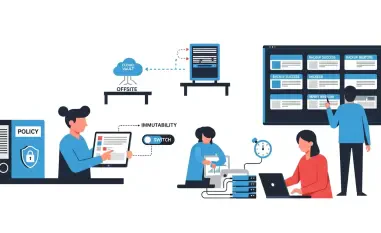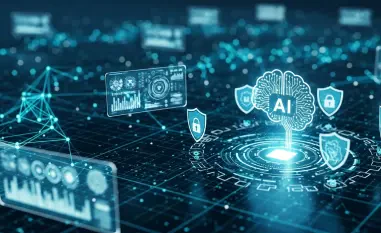In a world where security is paramount, advancements in technology have steered traditional access methods toward newer, more secure solutions. The wide adoption of face recognition technology signifies a pivotal shift in enhancing secure building access by leveraging biometric authentication methods. This evolution transcends conventional systems that rely on tangible items—such as keys, cards, or PIN codes—by transforming security protocols into seamless, efficient processes that operate intuitively. By utilizing one’s face as a credential, this technology challenges existing norms and fosters a narrative of security that is both comprehensive and user-friendly. It is a move towards more efficient and secure environments, ensuring personal safety and privacy remain top priorities.
The Evolution of Access Control
From Physical Keys to Biometrics
The journey from physical locks and keys to modern biometric systems highlights considerable technological progress over time. Traditionally, access to secured areas relied heavily on material items or knowledge-based methods, like keys or passcodes, which, although useful, were susceptible to theft, duplication, and other vulnerabilities. Consequently, innovative solutions emerged—magnetic cards, RFID tags, and numeric keypads—each enhancing security and convenience incrementally. These alternatives introduced the digital side of security, mitigating some physical vulnerabilities while amplifying other concerns such as cyber threats and system malfunctions.
Biometrics offered a game-changing advantage, deploying inherent physiological characteristics of individuals for authentication. Among these, face recognition stands out due to its non-intrusive nature and capability to blend seamlessly into everyday life. Unlike previous methods, biometric authentication using facial data eradicates the need for any intermediary physical token, bridging the gap between secure identification and convenience. As systems further integrate this technology, access control becomes not merely a barrier against intrusion but an intelligent network anticipating and adapting to human interaction within built environments.
Impact of Face Recognition Technology
Face recognition technology executes a fundamental overhaul of security design within physical spaces, balancing elements historically viewed as incompatible: heightened security, improved user experience, and operational efficiency. Biometrics enhance the security landscape, providing a multi-faceted shield against unauthorized entry. The technology embeds within systems, harnessing algorithms to analyze facial features—geometry, texture, dynamics—ensuring accurate identification even under adverse conditions like variations in lighting or posture changes.
In enhancing user experience, this technology smooths the entry process, rendering interactions more natural and intuitive. The removal of cumbersome access items liberates individuals from the routine of managing keys or cards, reflecting a streamlined, hands-free approach to building access. Moreover, logistical efficiency amplifies as operations transition to minimal human intervention, enabling automation that reduces resources devoted to traditional access management. These developments underscore a transition towards integrating seamless digital experiences into physical domains, realizing a cohesive interaction model previously fraught with disjointed elements. The broader adoption of facial recognition initiatives indicates a growing commitment to future-ready security solutions, transforming built environments into responsive spaces maintaining secure and fluid entry.
Technological Advancements
Scientific Foundations of Face Recognition
A distinctive feature of face recognition technology lies in its deep scientific foundation, stemming from studies and algorithmic progress up to present years. Initial systems mapped specific facial landmarks, relying heavily on geometric layouts or characteristics to identify individuals. However, technological progress in computer science, particularly in deep learning and artificial intelligence, catapulted this form of biometric from a surveillance novelty into a highly reliable security resource. Advanced algorithms today derive sophisticated mathematical embeddings from millions of facial scans, bolstered by machine learning techniques that continuously enhance identificatory accuracy and system reliability.
This evolution involves detailed examination of not only facial geometry but multidimensional data analysis. Systems now incorporate textural and dynamic elements and even thermal mapping to generate robust biometric profiles. These scientific developments ensure security infrastructure’s adaptability, supporting diverse use scenarios and addressing potential threats from spoofing and fraud attempts. Furthermore, as systems meticulously analyze biometric data, they fortify security mechanisms against challenges like identity cloning or manipulation, promising improved safety and integrity across various operational contexts. Intrinsic to modern security design, face recognition exemplifies the harmony between advanced science and practical deployment, forging secure and capable environments that prioritize user experience.
Integration into Various Sectors
The adoption of face recognition technology extends beyond building access control, with varied applications across multiple sectors. A notable example involves mobile devices implementing facial recognition for secure authentication, where personal security against unauthorized access becomes paramount. In airports, agencies such as U.S. Customs and Border Protection employ facial recognition systems for swift and precise identity verification of travelers, easing bottlenecks in processing traffic while enhancing international security measures.
Significant strides are evident within financial services, where facial verification mitigates fraud concerns, ushering breakthroughs in user identification and transactional security. Healthcare sectors also benefit, leveraging biometrics to improve record accuracy and patient management while safeguarding sensitive medical data. Moreover, airlines streamline boarding processes through facial recognition, reducing logistical hurdles and affording travelers punctual, seamless experiences. In retail environments, this technology augments security measures while enabling personalization, generating tailored experiences based on recognized customer identities. Across diverse contexts, face recognition reinforces security frameworks, ensuring effortless, authenticated transactions and services that elevate user expectations in contemporary settings.
Unified Systems and Challenges
Integration Simplicity: The XS4 Face Paradigm
A significant trend in face recognition technology is the consolidation into unified solutions, exemplified by products like the XS4 Face. This device aims to streamline deployment complexities by incorporating algorithms, hardware, and software within a singular framework. Instead of grappling with fragmented systems composed of multiple vendor components, cohesive products assure consistency and seamless operation. For mission-critical security infrastructure, reliable implementations are crucial, reducing integration errors and ensuring operational efficacy.
The XS4 Face embodies this paradigm, emphasizing an intuitive interface that accommodates structured integration processes. By consolidating security features, it facilitates streamlined workflows, enhancing overall user satisfaction. Integration simplicity serves not only technical goals but redefines user interaction, fostering environments cooperating with human presence naturally. This alignment between technological capability and user-centric design highlights the commitment to superior security solutions rooted in accessible innovations that promise increased reliability, coherence, and resilience.
Addressing Privacy and Ethical Concerns
The expanding scope of face recognition technology introduces pivotal privacy and ethical concerns, necessitating decisive strategies to address potential challenges. Unlike traditional identification methods, biometric data is intrinsic, demanding meticulous handling and safeguards against misuse or unauthorized access. Realizing these concerns has prompted providers to embrace “privacy by design,” concepts that embed security within core systems to mitigate risks.
Key strategies include encrypting biometric data within mathematical templates, reducing external vulnerabilities, and processing data locally to diminish exposure compared to centralized control models. Providers consciously differentiate authentication practices from mass surveillance operations, advocating informed consent and optional participation as fundamental principles. Legal compliance with guidelines like GDPR ensures system designers carefully balance technological progress with accountability and transparency, essential elements in preserving user trust.
Beyond legal frameworks, ethical considerations permeate dialogue, reflecting societal values around privacy and individual autonomy. Transparent communication and respectful data handling promise cohesive relationships between technology providers and users, confirming face recognition systems as responsible innovators serving present-day security needs while safeguarding individual liberties.
Future Considerations
The Ubiquity of Face Recognition
As face recognition technology integrates into wider contexts, its ubiquity promises transformative changes within societal paradigms. Beyond mere physical security, technology now considers realms where facial recognition acts as universal keys enabling customized interactions and transactions. Future environments postulate dynamic adaptation to individual presence, offering settings and services crafted to individual preferences fostering personalized experiences.
Such adaptation involves incorporating facial recognition into smart systems governing environment variables—from lighting and temperature to sound and privacy levels—constructing scenarios responsive to recognized users. These opportunities underscore not only technological prowess but multifaceted intelligence applications presenting secure, intuitive encounters where personalization elevates user satisfaction.
A future pioneering face recognition technologies introduces diverse opportunities harnessing inherent biometric features for smart, secure interactions. As technology progressively permeates infrastructure, societal and cultural shifts follow, reflecting balanced integration where user choice reigns. Promising security through personalization steers face recognition practices beyond basic safety measures toward enriched, harmonious environments engaging human needs authentically.
Conclusion: Shaping the Future of Security
In today’s world, where security concerns are at the forefront, technological progress is steering traditional access methods toward innovative solutions that offer higher security levels. The widespread implementation of face recognition technology marks a pivotal transformation in the quest for enhanced building security through biometric authentication. This technological leap goes beyond conventional systems that depend on physical items—such as keys, cards, or PIN codes—by transforming security measures into seamless and efficient processes that inherently operate with ease. Utilizing a person’s facial features as authentication introduces a new standard, promoting a security narrative that is both comprehensive and user-friendly. This evolution signifies a transition toward environments that prioritize efficiency and security, ensuring that personal safety and privacy are held in the highest regard. Face recognition technology has the potential not only to streamline access procedures but also to reshape our understanding of security, making it more intuitive and integrated into daily interactions. As security technologies continue to advance, it is clear that biometric solutions like facial recognition are paving the way for safer and more secure spaces, challenging traditional norms and providing an elevated sense of protection.













